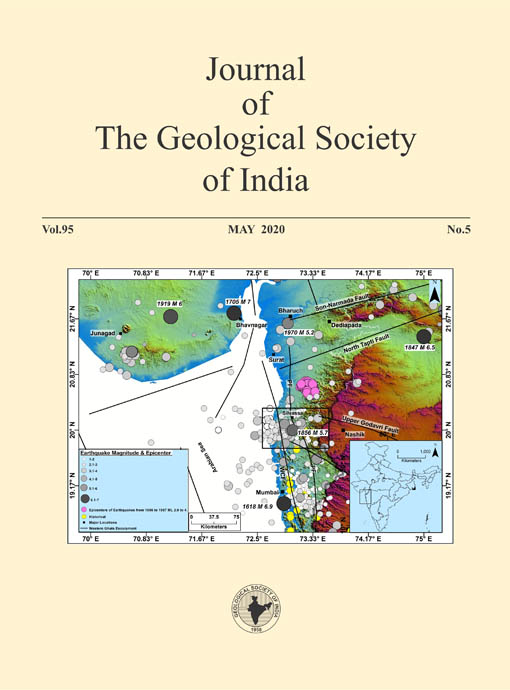Assessment of Aquifer Vulnerability Using GALDIT Model – A Case Study
DOI:
https://doi.org/10.1007/s12594-020-1469-1Keywords:
No Keywords.Abstract
With the increasing urbanization, agriculture, industrial activities along the coastal stretches of India, more and more people depend on ground water due to which there are cases of large scale decline in both quantity and quality. One of the State which is facing a critical change in its geomorphology and land use/land cover is Goa which is known for its tourism industry. Therefore, the water management will be a major issue in the years to come. A field survey conducted in parts of north Goa coast to understand the ground water availability status, quality issues and salinity conditions of ground water due to sea water intrusion. Accordingly, an attempt was made to understand the extent of seawater mixing with ground water using a model known as GALDIT Model. GALDIT is an indicator based model which assess and quantifies the significance of vulnerability to seawater intrusion due to excessive groundwater withdrawals. The system contains three significant parts: weights, ranges, and ratings. Each GALDIT factor has been evaluated with respect to the other to determine the relative importance of each factor. Accordingly indices were calculated for the selected wells (wells were selected along the coast and also perpendicular to the coast). Results obtained by GALDIT model showed that about 42% of the wells in the study area are low vulnerable and 58% of the wells are moderately vulnerable to sea water intrusion.Downloads
Metrics
Issue
Section
Downloads
Published
How to Cite
References
Aller, L., Bennett, T., Lehr, J.H., Petty, R.J. (1985) DRASTIC: A standardized system for evaluating ground water pollution potential using hydrogeologic settings Report EPA/600/2-85/018. Washington DC US Environmental Protection Agency. pp. 163
Barbash, J.E., Resek, E.A. (1996) Pesticides in the hydrologic system series. In: Pesticides in groundwater: distribution, trends, and governing factors. Ann Arbor Press, Chelsea, Michigan, v.2, pp.590.
Brosig Karolin, Geyer, T., Subah, A., Sauter, M. (2008) Travel time based approach for the assessment of vulnerability of karst groundwater: the Transit Time Method. Environ Geol., v.54, pp.905-911.
Chachadi, A.G. and Lobo Ferreira, J.P. (2001) Seawater intrusion vulnerability mapping of aquifers using the GALDIT method. COASTIN - A Coastal Policy Research Newsletter. Proceedings of the Workshop on Modelling in Hydrogeology, Anna University, Chennai. pp.143-156.
Kumar, C.P., Sudhir Kumar, Purandara Bekal (2007) Modelling of Seawater Intrusion in Coastal Area of North Goa. Water Digest, v.2 (3), pp.80-83.
Lobo-Ferreira, J.P. and Oliveira Manuel, M. (2004) Groundwater vulnerability assessment in Portugal. Geofisica International, v.43(4), pp.541-550.
Lobo-Ferreira, J.P. and Cabral, M. (1991) Proposal for an operational definition of vulnerability for the European community's atlas of groundwater resources. In: Meeting of the European Institute for Water, Groundwater Work Group, Brussels.
Margat, J. (1968) Groundwater vulnerability to contamination. Orleans, BRGM Publication. pp. 68.
Neshat Aminreza, Pradhan B, Pirasteh S, Shafri Hzm (2014) Estimating groundwater vulnerability to pollution using a modified DRASTIC model in the Kerman agricultural area, Iran. Environ. Earth Sci., v.71, pp.1-13.
Panagopoulos, G.P., Antonakos, A.K., Lambrakis, N.J. (2006) Optimization of the DRASTIC method for groundwater vulnerability assessment via the use of simple statistical methods and GIS. Hydrogeology Jour., v.14, pp.894-911.
Shirazi, S.M., Imran, H.M., Akib, S., Yusop, Z., Harun, Z.B. (2013) Groundwater vulnerability assessment in Melaka state of Malaysia using DRASTIC and GIS techniques. Environ. Earth Sci., v.70, pp.2293-2304.
Shirazi, S.M., Imran, H.M., Akib, S. (2012) GIS-based DRASTIC method for groundwater vulnerability assessment: A review. Jour. Risk Res., v.15(8), pp.991-1011.
Tesoriero, A.J., Inkpen, E.L., Voss, F. (1998) Assessing groundwater vulnerability using logistic regression. Proceedings for the Source Water Assessment and Protection 98 Conference, Dallas, TX, pp.157-165.
Venkateswara Rao, S. and Subba Rao, N. (1988) Criteria for recognition of salt water in coastal aquifers. Jour. Groundwater News, v.7(9), pp.9-12.
Zhang, R, Hamerlinck, J.D, Gloss, S.P. and Munn, L. (1996) Determination of nonpoint-source pollution using GIS and numerical models. Jour. Environ. Quality, v.25, pp.411-418.

 Vidya Sujitha
Vidya Sujitha






